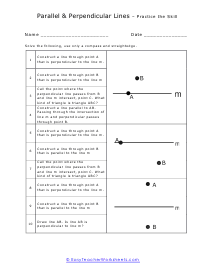What are Parallel, Perpendicular, and Intersecting Lines? In geometry, there are three different types of lines, namely, parallel, perpendicular, and intersecting. Parallel - Lines that move in their specific direction without ever intersecting or meeting each other at a point are known parallel. As they never meet or intersect, the distance between also remains the same. Some real-life examples of parallel lines are the railway tracks. Have you seen how the railway tracks run on the ground? They are quite apart from each other and seem like they never meet. The rails of the track extend individually without meeting each other, and the distance between them is also unchanged. Another example is the edges of a writing pad or note book. Perpendicular - They meet each other at a certain point and form a right angle are known as the perpendicular. Some real-life examples of perpendicular lines include the tiles meeting each other at a right angle. You must have seen how a pizza is sliced, right? They are cut in lines from the middle, and sideways. Notice how at the center, they meet? Any arrangement that allows two lines to be set at 90 degrees are examples of being perpendicular. Intersecting - They seem to cross each other or meet at a point when extended to some length are known as the intersecting. The point where these they meet is known as the intersection point. For example, pizza slices!
We will work on identifying and making sense of line pair classification. Parallel lines are two lines that are always the same exact distance apart and never touch each other. The construction of the walls in your home were created with some parallels. Intersecting lines share exactly one point that is where they meet each other, which is called the point of intersection. Perpendicular lines meet at a right angle. We will explore each of these qualities of lines over this chest of worksheets. These worksheets explain how to classify and construct parallel and perpendicular lines. Students will calculate angles, determine if lines are intersecting, perpendicular, or parallel, identify angles, and more.



















































